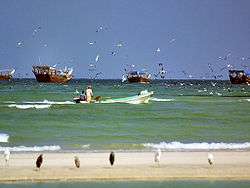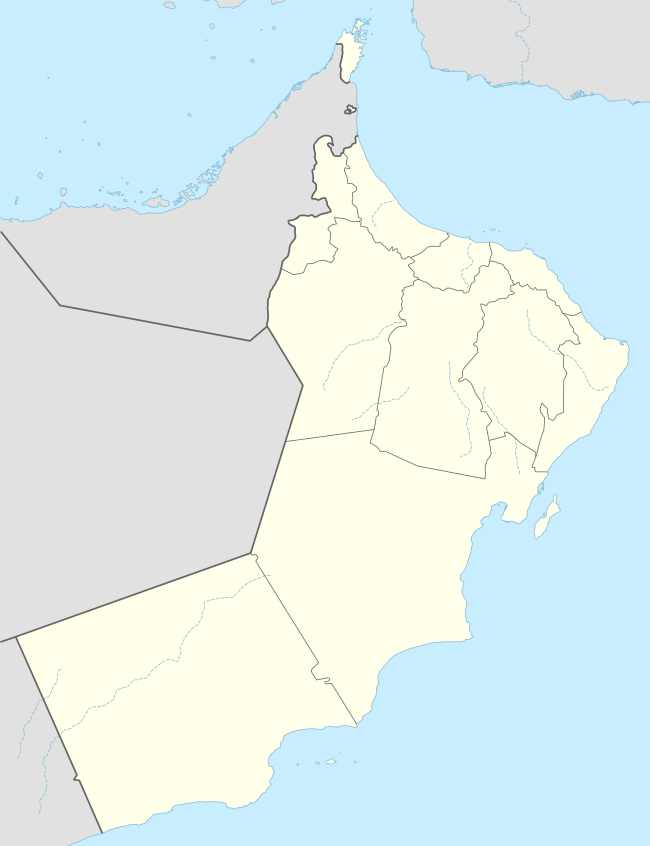Duqm
Duqm (Arabic: ٱلدُّقْم, romanized: Ad-Duqm) is a port town on the Arabian Sea in Al Wusta Governorate in central-eastern Oman. The town is currently experiencing significant development, growing from about 5,100 in 2008 to over 11,200 people in 2010,[1] and the Oman Tourism Development Company is looking to develop it into a resort, aiming to increase its population to 100,000 by 2020.
Duqm ٱلدُّقْم (in Arabic) | |
|---|---|
 Duqm | |
 Duqm Location in Oman | |
| Coordinates: 19°39′42″N 57°42′17″E | |
| Country | |
| Region | Al Wusta Region (Oman) |
| Wilayat | Duqm |
| Time zone | UTC+4 (UTC+04:00) |
History and economy
Duqm was a small fishing settlement of the Janubah tribe on the coast of southern Oman,[1] when a party of soldiers of the Muscat and Oman Field Force and geologists of Petroleum Development Oman landed in February 1954 to begin the modern oil exploration of central Oman.[2][3]
Today it is an industrial oil town with a notable port. The town has been looking to increase tourism in the area with the Oman Tourism Development Company, and is now central to the state's development goals, with a 25-year plan formulated in 1995 to increase its population to 100,000 by 2020.[4] The port has undergone development and a shipbuilding facility to facilitate the port was built; development has been ongoing by the Jan De Nul Group, improving the breakwaters and quay walls.[5] In March 2005, Oman's Ministry of Transport and Communications awarded the Parsons Corporation a contract to study and design a new Duqm Jaaluni Airport in hopes of increasing tourism. Oman Air has begun services at the airport on July 23, 2014.[6] The planned Oman Railways project will also include a link to Duqm Port.[7] In 2008, Intercontinental Hotels announced they were to build a 213-room hotel, Crowne Plaza Duqm.[8] A coal-fired power plant has also been approved in Duqm with the aim of reducing dependency on natural gas, and Oman has formed a $2 billion deal with South Korea to facilitate it.[9][10] Duqm's port and industrial zone has also received heavy Chinese investment.[11]
According to The Economist in 2013, "If Duqm took off, sleepy Oman might—say the planners—challenge nearby Dubai’s dominance as the region’s trading hub" with a geographically favourable location that links to Asia, Europe and Arabia, that also avoids the tensions of the nearby Persian Gulf.[12]
Special Economic Zone Authority at Duqm
The Duqm Special Economic Zone Authority (SEZAD) is responsible for the management of all economic activities in Duqm, including long-term strategies of infrastructural development and investment. It is also required to oversee the urban expansion of Duqm city while protecting the environment. The SEZAD registers, licenses, and provides environmental approvals using internationally recognized practices. Imports into the zone will be duty-free. Further regulations regarding the Zone's company registrations, labor, trade, land, taxation, incentives are planned. It is intended that SEZAD tax regimes, land lease rates, and utility tariffs will be provided at competitive rates.[13]
Transportation
Duqm International Airport, which opened in 2014, offers nonstop service to Muscat via Oman Air.
The Omani government's ambitious railway network plan, though at a primitive stage is gaining pace despite the low fuel prices. Thanks to the public-private investments, the government is going ahead with the Oman Mineral Railway link. It is expected that SEZAD will be connected via a railway link from the different wilayats of Oman. Connectivity is planned from Duqm Port to Shuwaimiyah and Manji, and potentially to Thamrait — locations in Dhofar Governorate that host prolific non-metallic mineral reserves.[14]
Climate
| Climate data for Duqm | |||||||||||||
|---|---|---|---|---|---|---|---|---|---|---|---|---|---|
| Month | Jan | Feb | Mar | Apr | May | Jun | Jul | Aug | Sep | Oct | Nov | Dec | Year |
| Average high °C (°F) | 26.8 (80.2) |
27.5 (81.5) |
30.4 (86.7) |
34.3 (93.7) |
36.2 (97.2) |
36.3 (97.3) |
33.0 (91.4) |
32.4 (90.3) |
32.5 (90.5) |
32.7 (90.9) |
30.5 (86.9) |
27.6 (81.7) |
31.7 (89.0) |
| Average low °C (°F) | 17.6 (63.7) |
18.4 (65.1) |
20.8 (69.4) |
23.8 (74.8) |
26.2 (79.2) |
26.5 (79.7) |
24.5 (76.1) |
23.6 (74.5) |
23.7 (74.7) |
22.5 (72.5) |
20.6 (69.1) |
18.8 (65.8) |
22.3 (72.1) |
| Average precipitation mm (inches) | 2 (0.1) |
5 (0.2) |
7 (0.3) |
10 (0.4) |
0 (0) |
3 (0.1) |
1 (0.0) |
4 (0.2) |
0 (0) |
1 (0.0) |
1 (0.0) |
2 (0.1) |
36 (1.4) |
| Source: Climate-data.org | |||||||||||||
See also
| Wikivoyage has a travel guide for Duqm. |
- Al Duqm Port & Drydock
- Masirah Island
- Railway stations in Oman
- Transport in Oman
References
- The Report. Oxford Business Group. p. 278. ISBN 978-1-907065-72-9.
- The Journal of Oman Studies. Ministry of National Heritage and Culture, Sultanate of Oman. 1983. pp. 152–7.
- Morton, Michael Quentin (May 2006), In the Heart of the Desert (In the Heart of the Desert ed.), Aylesford, Kent, United Kingdom: Green Mountain Press (UK), ISBN 978-0-9552212-0-0, 095522120X, archived from the original on 2018-06-03, retrieved 2011-06-27
- The Report: Oman 2012. Oxford Business Group. 2012. p. 159. ISBN 978-1-907065-49-1.
- PIANC Yearbook 2011. PIANC. p. 295. ISBN 978-2-87223-194-2.
- "Oman Air to inaugurate Duqm Jaaluni airport's operations". ch-aviation.com.
- "Oman's rail project on track". Oxford Business Group.
- "Description of Crowne Plaza Duqm". Crowne Plaza Hotels.
- International Energy Outlook, 2010. U.S. Energy Information Administration, Government Printing Office. 24 August 2010. p. 94. ISBN 978-0-16-088158-9.
- Minerals Yearbook, 2008, V. 3, Area Reports, International, Africa and the Middle East. Government Printing Office. 24 October 2010. p. 52. ISBN 978-1-4113-2965-2.
- "Oman is benefiting from the standoff over Qatar, for now". The Economist. 30 Aug 2017.
- "Oman's new port: Sleepy no more". The Economist. 6 April 2013. Retrieved 22 November 2013.
- "SEZAD Profile". Special Economic Zone Authority at Duqm. Retrieved 22 September 2014.
- "Oman Rail". CEMNET.COM.